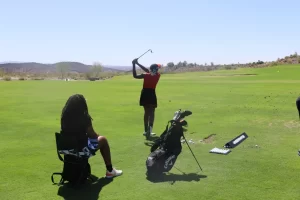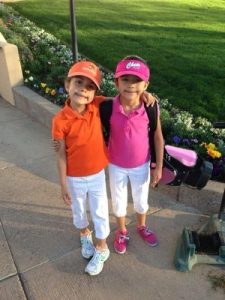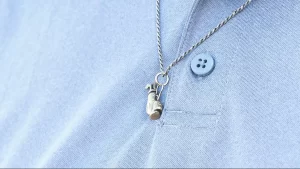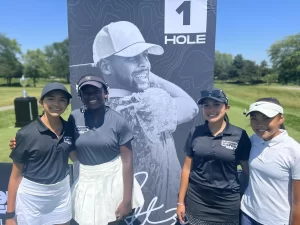- Slug: Sports-Golf Graduates, 1550 words
- 4 photos available
By Lauren Green
Cronkite News
PHOENIX – A hole-in-one sank at the par-3 third hole on a heated desert golf course in April 1946. It was uncommon at the time, and remains so today, but this occasion was even more of a rare sighting because of the Black man behind the swing. The Encanto Golf Course in downtown Phoenix was the only place for minorities to golf at the time.
The golfer’s name remains unknown, but his club of choice, a “mashie” – a club resembling a modern-day five-iron – carries a piece of the historic group. It’s only fitting that after the luck from the “mashie,” 10 Black golfers formed a golf club that same year and called it Desert Mashie.
“Well, in 1946, if you are Black, you were Hispanic, you were Native, you were Asian, this was the only place that you could play — It was in Encanto,” said Desert Mashie Golf club president Booker T. Evans.
Desert Mashie, which joined the United States Golf Association (USGA) in 1950, originally formed for minorities and now has evolved into an organization that welcomes any golfer who wants to learn the game and be involved in the community. The founding members ensured that the club’s values would be guided by non-discriminatory practices of race or gender. Over nearly 80 years, these principles are evident in the significant increase in membership for Black women and girls.
Evans found his way into the club in 1990 with some encouragement from his wife. He hasn’t left the golf course since.
“She thought that I worked too much, spent too much time at the office,” Evans said. “So she ordered me a set of ping irons, and they came to the office and I started to play the next weekend.”
After playing with friends and notable golfers like Bill Dickey, Evans was invited to join the club. Dickey, who founded the National Minority Junior Golf Scholarship Association, was Desert Mashie’s president at the time and had been a member of the club since 1950, before offering the $25 lifetime membership fee to Evans.
Since then, Desert Mashie has grown to around 180 members. Nearly 30 members don’t play golf but help the organization’s growth and community efforts.
“The people just support the organization, support the junior program, support the things we do and food drives and raising funds and things of that nature, and we’re as happy to have them as we are to have, golfers, come and play,” Evans said.
Generational Ties
Sean Colebrook, Encanto Golf Course tournament and junior director, found his love for golf at the age of seven after always asking his mom about his dad’s whereabouts. Colebrook grew up playing basketball and baseball, but upon learning his dad was spending his leisure time on the golf course, he latched onto his hip on the fairway and never looked back.
“I fell in love with it right away, and I knew that’s what I wanted to do and that’s all I pursued was golf,” said Colebrook, who helps mentor the club’s younger members.
Colebrook’s late father, George Colebrook, held nearly every position for Desert Mashie before passing away as the tournament director in 2016. Sean took over as tournament director, following in his father’s footsteps, and still walks the course with him by way of a small golden golf necklace with his ashes.
Playing golf in the 1970s and 1980s as the only minority on the course wasn’t always easy, Sean recalled. The mental strain of feeling different made it difficult to find comfort and belonging in the predominantly white golf clubs. It even changed his approach to the game.
“They say the hardest shot in golf is the first one off the tee box,” Sean said. “As a Caucasian, you really don’t know how really difficult that is when you’re a minority and you’ve got to hit that first shot knowing that everybody don’t think you belong there, so I practiced that first shot more than anything.”
What changed Sean’s approach to the game were words from former Sun Devil and PGA golfer Billy Mayfair, who forever altered his outlook on the sport.
“I’ll never forget it,” Sean said. “I mean, he pretty much changed my life for golf. And I started feeling accepted because he basically said, ‘Play the course. The course knows no race.’”
Mayfair’s everlasting guidance from years ago now echoes into the new generation of golfers as it leads the lessons that Sean teaches to Desert Mashie’s junior golfers today.
“No matter whether you play Pebble Beach or you play Encanto, yardages are the same yardages, and you realize that you’re playing against this course,” Sean said. “These designers designed these courses to make it difficult for you; they don’t see race. These trees, these birds, they don’t see race.”
The New Generation
The future appears to be bright for underrepresented groups, which benefit from new initiatives and resources that didn’t exist a few years ago. Desert Mashie is one promising sign of the talent on the rise with better overall support for minority golfers.
Five girls from Desert Mashie participated in the inaugural Mack Champ Invitational last year – a golf tournament founded by PGA golfer Cameron Champ. The invitational hosts the best junior golfers from diverse backgrounds across the country.
All the members of Desert Mashie that participated in the Mack Champ Invitational tournament are also playing in Stephen Curry’s brand-new tournament for minority golfers. The four-time NBA champion’s Underrated Golf Tour started this year and includes an all-expense paid nationwide tour throughout the summer.
Curry started the tour to allow minorities to have a large platform to be noticed and to have access to the sport. The tour also allows junior golfers to experience a real professional golf tour while teaching them life lessons from esteemed panel speakers at every tour stop.
Curry’s five-stop tour came to Arizona in July at the Wickenburg Ranch, where a few familiar Desert Mashie faces battled it out in their home state against other top junior golfers on the tour.
Mexican American sisters Natalia and Alexis Lamadrid, who both have played golf since they were four years old, were two of five Desert Mashie members. The teenagers are grateful for the experience.
“It feels like an honor, for such a superstar in the world to make something for us, minorities and golfers that do not get appreciated every day,” Natalia, 13, said. “For him to appreciate us, it just means the world.”
Participation in the new-age tournaments derived for minorities is starting to become habitual for these athletes, something that shows a sign of progress in the sport. With more new initiatives for junior golfers comes more positive effects the sport can have on golfers from a young age. Even for young golfers like Desert Mashie member Ashley Shaw, the tours are sparking a change and making a notable difference.
“You don’t usually see a lot of people who look like us playing this game,” Shaw,13, said. “And to see that there are others here, that are you know, good, and that we know what we’re doing – it’s encouraging and inspiring to keep going.”
While the people who play golf aren’t necessarily considered the problem, the sports’ culture rooted in racial indifferences is what still resides in golf’s issues today.
The first American-born golf professional was said to be John Shippen in 1896, who came from Native American and Black descent. Dr. George F. Grant, the second Black doctor to earn a dentistry degree, was the first to patent the wooden tee just a few years later in 1899.
Then in the 1990s and early 2000s, Tiger Woods changed the perspective of golf with his dominance and style of the game that created a new wave of everyday spectators and golfers.
Black culture has always been embedded into this sport, but there are only four Black PGA golfers on tour right now out of the 260 golfers behind Tiger Woods, Cameron Champ, Joseph Bramlett, and Harold Varner III.
“I think people that generally play golf are generally nice people,” Evans said. “It’s the administration of golf that has been the problem with the PGA and its racial exclusions up until the early 1960s. You know, things of that nature; the Master’s not allowing any African-Americans to play.”
With the influence Desert Mashie, Curry’s Underrated Tour and the Mack Champ Invitational, golf is beginning to have new opportunities for underrepresented communities that didn’t exist a few years ago. These new opportunities are helping grow and expose the sport to all communities, and leaving behind racism and discrimination, to break new boundaries on the course.
New diversity initiatives in other sports have already begun to see success such as this year’s MLB draft, where four of the top five draft picks were Black players who competed in the MLB’s Dream Series, a showcase aimed at diverse and predominantly black high school baseball pitchers and catchers.
With these success stories and new historical landmarks happening in other sports for minorities, the trend seems to be heading in the right direction to change golf’s current course too.
For more stories from Cronkite News, visit cronkitenews.azpbs.org.



